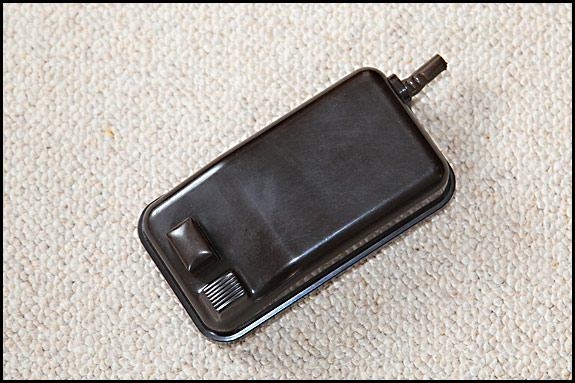And just so we’re clear what I’m on about, it’s this thing, as opposed to the earlier or later all-metal ones, or indeed the more modern “clamshell” types …
That is your common or garden Singer Sewing Motor Controller 194585 if it’s black, 194589 if it’s light brown/café au lait, and 196469 if it’s dark brown, and believe it or not some people get bent out of shape if, like most folk do, you call it a foot pedal. Foot controller is tolerated (just), as is button controller, but definitely not foot pedal. Presumably that’s because it isn’t a pedal like on a piano. Or on a bicyle, come to that.
They should get a life. OK, let’s move on to the proper way in which you use one of these things, because whilst it might be obvious to you, it’s certainly not obvious to everybody. So, you put it on the floor with the lead going away from you, you put your heel on the carpet, and you put the ball of your foot over the two sticky-up bits at the front. The right-hand one of those is your footrest. It doesn’t move. The left-hand one does move, and is what does the business when you press down on it.
What confuses people is how you press down on that left-hand “button”. What you do not do is swing your foot off the footrest onto the button and then press it down. What you do instead is keep your heel on the floor and keep the ball of your foot over both wossnames, then tilt your foot to the left in order to depress the go-faster button enough for the machine to do your bidding. The sole of your shoe stays in contact with the footrest.
If you’ve never tried it, that’s going to seem a really weird way of pressing down on a button, but it very quickly becomes a natural action – and with a bit of practice you can get very fine control indeed.
So, why is it designed like that? Simple – it’s to stop you sitting there with your foot resting on the go faster button, and without realising what you’re doing, depressing it slightly. And why might that matter? Because when your foot’s clear of that button, there’s no current flowing to the motor and nothing happens. However, if you press down just a bit, most of the current which would otherwise get to the motor is converted into heat inside the controller, which of course gets warm. Keep that up long enough, and the controller will get hot, which is not good.
Enough pressure to start the motor is OK, because as you press down more, more current is allowed through to the motor (so it can start then speed up) and less current is converted into heat. When your foot’s hard down, all the current is (or rather should be) going straight to the motor.
Or to put it another way, if you were to bypass the controller, the motor would run flat out. What slows the motor down is the controller converting some of the current into heat, and the more you slow the motor down (by easing your foot up on the button) the more the innards of the controller heat up. It’s that heating which is the potential problem . So the way it works is …
Foot off completely – no current flow, no heating up, no problem.
Foot just slightly pressed down – maximum amount of current converted to heat in controller, so controller heats up. Minimum amount of current goes to motor, but not enough to start it turning.
More pressure – more current goes to motor, which runs faster, so less heat build-up in controller.
Foot hard down – all current goes to motor, which runs flat out. No heat build-up.
If you’ve got that clear in your head, it’s probably occurred to you that when you’re doing something involving multiple long seams sewn at slow to moderate speeds, your foot controller is going to get hot. It’s designed to cope with that, but it’s still a good idea to let it have a breather every now and then.
If you use it properly (ball of foot always on the footrest) and you let it cool down whenever you get concerned about how hot it’s got, the foot controller’s actually pretty much bulletproof. They can go wonky though, so we’ll have a look at what’s inside one and get a bit technical about it in another post before much longer.

You must be logged in to post a comment.